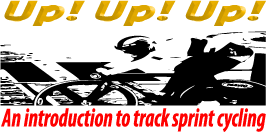A simple race
Keirin tactics are pretty simple, at least at first.
Broadly speaking there's three positions you can be in once the dust settles from the start.
You're either leading in first or second wheel, trailing in fifth to seventh wheel or stuck in the middle in third or fourth wheel.
How it pans out once the motorcycle pulls off depends on your position.
If you're leading you have two choices. You either lead out the race or wait for a flyer and jump on the flier. It's very difficult at elite level to lead out and win, although for a long time Chris Hoy was good at it, but it can be done if you can control the pace at first and have enough energy left for the last lap but it's a high risk strategy. Generally in first (or second, if first isn't paying attention) wheel your best option is to wait for the flier from the back (it will come!) and pounce on the wheel when it does, lay off a few metres, control the pack behind you by owning the sprinters lane and accelerate into your leadout's slipstream and pass them as late as possible to win. A textbook example of this is Jacob Schmid winning the under 19 mens Australian Keirin title in 2011. The following year Jaegan Castles won the Oceania J19 keirin by leading out from the motorbike and controlling the pace. Both can work but waiting for the flier is probably a better strategy unless you're a kilo rider. When you wait for the flier you have to be sure to be watching behind you, if you don't accelerate until the rider overtaking is beside you, it's way too late and you'll miss the wheel. As soon as you see a move starting, accelerate so you have options, not at full speed, but enough to minimise the speed difference and let you get second wheel. Jacob in the video above, did this very well.
If you're at the back you either have to take a flier or follow someone else who does. An example of this is Ryan Bailey and an unfortunate Josiah Ng as his chaser at the 2004 Athens Olympics. In this example Bailey was initially at second wheel but the flier came early from Jose', and Bailey dropped to the back before taking a flier himself with two laps to go. Note how Bailey lets Shane Kelly's wheel go before the motorbike peels off to give himself room to move. The flier doesn't always work but if you're at the back you're probably going to have to do it, or chase someone who does.
If you're in the middle, you have choices galore. You can wait for a flier and chase it, you can take a flier yourself or you can count on following the leaders and getting past them. Being boxed in is your big risk by being in the middle but sometimes you can find a way through traffic.
Finally, if at the start you don't get the position you want and no-one will let you in, pull out early and go to the back. You'll just waste energy trying to muscle in and if no-one will quickly let you in you can't push like in the old days. Go to the back, reassess your plan and get ready to take a flier to get near the front.
